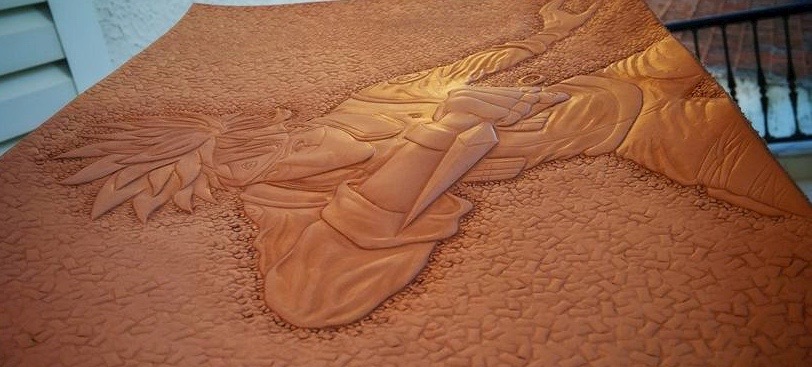-
Posts
2,372 -
Joined
-
Last visited
Content Type
Profiles
Forums
Events
Blogs
Gallery
Everything posted by immiketoo
-
Running a guild is a LOT of work. It requires paperwork, a board, Robert's rules and the like. Contact the IFOLG for information on how to get started. They will send you a packet that needs to be filled out and point you in the right direction. Good luck! If you do get one started, I know a lot of people in your area who might be interested.
-
Congrats, Jo! That's an awesome achievement and I'm glad you're a proud mom!
-

how can you make airbrushed dyes penetrate deeper?
immiketoo replied to Jarednem's topic in How Do I Do That?
Well, nothing can take the place of dyes applied with wool, and the question was can help the dye soak deeper, not as deep as. Oiling before and after your dye coats will help improve the durability of the finish beyond just spraying it, but if you want dauber depth you'll have to get good at making even colors and fades sans airbrush. It can be done, but its not easy.- 13 replies
-
- airbrush
- dye penetration
-
(and 1 more)
Tagged with:
-
Steve and crew do an outstanding job in a world where other vendors just don't seem to care. Its refreshing to say the least.
-

how can you make airbrushed dyes penetrate deeper?
immiketoo replied to Jarednem's topic in How Do I Do That?
Yes, sorry. Now, to be clear, we're not talking about the depth as if you'd used wool or cloth to apply the dye, but it makes a big difference in the fragility of the sprayed dyes.- 13 replies
-
- airbrush
- dye penetration
-
(and 1 more)
Tagged with:
-

how can you make airbrushed dyes penetrate deeper?
immiketoo replied to Jarednem's topic in How Do I Do That?
Let it absorb then spray. Once you put color on, oil immediately to set the color.- 13 replies
-
- airbrush
- dye penetration
-
(and 1 more)
Tagged with:
-
As I mentioned, the blades needed a lot of work to make them smooth, and I am not willing to spend the time to fix a blade just to send it back to the company. I know what the result would have been, so I didn't include a test run of an unfinished blade. You can find the knives here: https://www.rickert-werkzeug.de/en/General-tools/Leather-Knives-Cutting/?p=1
-

how can you make airbrushed dyes penetrate deeper?
immiketoo replied to Jarednem's topic in How Do I Do That?
Oil your leather before and after your spraying. You'll get better penetration, and you can spray heavier coats and not have to worry as much about excess dyestuffs.- 13 replies
-
- airbrush
- dye penetration
-
(and 1 more)
Tagged with:
-
No problem at all. Thats why they give us a delete button. Anyway, find some friends, buy some caps and you're good to go!
- 6 replies
-
- dye lids
- flip top lid
-
(and 1 more)
Tagged with:
-
You can buy them here. 144 caps for 29 bucks. https://www.sks-bottle.com/340c/fin111i.html Also, you double posted, so I cleaned up one of them.
- 6 replies
-
- dye lids
- flip top lid
-
(and 1 more)
Tagged with:
-

Most likelly my last one
immiketoo replied to katsass's topic in Gun Holsters, Rifle Slings and Knife Sheathes
Well THAT'S a huge relief. Still, if you can make stuff even after a couple of tries, its better than not making stuff! -
Some people would say its not the tools, but the skills. I say its a little bit of both, but knowledge goes a lot farther than a new tool. Unless its a black crack beveler
-
Thank you!
-
A quick review of some very nice knives.
-

Homemade tools and ways you have saved money on tools
immiketoo replied to JenGranger's topic in Leatherwork Conversation
Absolute truth! -

Homemade tools and ways you have saved money on tools
immiketoo replied to JenGranger's topic in Leatherwork Conversation
Mine just steals my tools and act innocent when I can't find them -

Homemade tools and ways you have saved money on tools
immiketoo replied to JenGranger's topic in Leatherwork Conversation
Well, shit. I haven't saved money anywhere. At all. But I do have an awesome set of tools! -
Everyone has their own order, and often the piece will dictate that order, but JLS has stated it the same as I and many others do it, with a few exceptions. If you're hand stitching, you might want to add stitch holes before dye, especially if you are using contrasting thread. Let the piece dry completely, and then stitch. That way, you wont have to touch up the holes after stitching.
-

Most likelly my last one
immiketoo replied to katsass's topic in Gun Holsters, Rifle Slings and Knife Sheathes
Mike, it pains me to read this, but it seems your spirits are high and thats good. Please stay active on the forum at least, and know that you have had a profound impact on my leatherwork career. BTW, there's nothing wrong with those items there. You still got it! -
For thin leather like that, I use a cocobolo burnishing stick with a very thin slot and a light touch. Just water is all you need.
-
I can't speak to 10 years ago, but the advent of Facebook groups has had an impact on all of the forums I belonged to. Leatherworker.net has survived and fared far better than any of the other forums I belong to, especially the automotive ones. Those places are ghost towns anymore. We are in control of how things happen here and I will keep working to keep the forum alive and well!
-
Yeah it's an epic series. You bring up a good point. Britt constantly modifies his tools to be able to tool small areas. Knowing your tools and your abilities is key. A man has to know his limitations!
-
I hear you man, but they are worth it. The work sheets alone will bump you years ahead. Each class is about an hour to an hour and a half. Thats a good way of looking at it. Another benefit of aids is tooling. You can do the same piece again and again until you've perfected the tooling. Once you understand how to tool it, that info can help you avoid pitfalls in design, like too much or too little background space, tricky intersections and learning what elements are on top.
-
Thanks for the mention. The classes by Britt are by far the easiest and most comprehensive way to learn floral design that I have seen. Britt breaks it down to the individual line level and then builds it back up from there. You almost can't not do it after his classes. However, there are a lot of other good publications out there as well, including Bob Park's book which is good and the Cary Schwarz videos are good as well. Copying and craft aids are great until you get tired of them or find yourself with a piece where they don't fit, so learning to draw it is highly recommended. If you're interested, www.learnleather.com.
-
Sound advice above. One thing I would add is that since you said you're new, she may try to leverage that against you as a means to reduce your price. Don't fall for that. She clearly recognized the quality in your work and spoke up about it. A LOT of people underprice their work because they're new, because they're shy or self conscious or a myriad other reasons. Things like electricity, heat and water all should be factored into your pricing, even the time and resources spent to pick up supplies and organize them in your shop. Pros know this, hobbyists in their garages often never even think of it. I agree with plinker cases. You've cracked the code and more people will be knocking on the door. What does a high end set of mass produced tack cost? Yours is hand made, with attention to every detail and the eye of an enthusiast. That equals $$$ or at the very least a counter argument to the, "well you're new" argument. Good luck.


